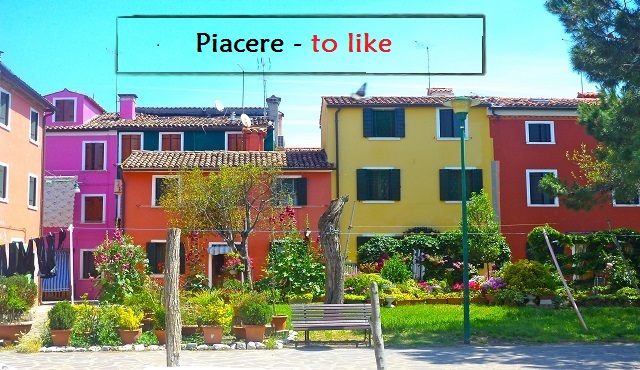The Italian verb piacere literally means “to be pleasing.” Italians use this verb when they want to show that they like something. It is how Italians say, “I like it!”
While Americans seem to “love” everything, the Italian response is more measured. In Italy, it’s important to be able to describe our likes and dislikes, and that’s where the verb piacere comes in handy. Piacere is a very important verb for travelers to Italy because there are so many places and things in Italy to like!
It should first be noted that piacere has an irregular conjugation. Also, because the verb piacere is most often used to refer to one or many things that we like, it works differently than the regular Italian verbs that have an -ere ending. In effect, the subject of the sentence that uses the verb piacere will be the thing or things that are liked, and therefore the conjugated forms of piacere that will be used most often are the singular and plural third person.
The singular third person form of piacere is piace and the plural is piacciono.
So, rather than conjugate the verb piacere in its entirety, for now we will focus on the two most important conjugations of piacere listed above.
Simple enough! But, the tricky part is actually how to use the verb piacere! First, we will discuss how we approach the topic in English. Then, read on to see how we must really learn to think in Italian when we use piacere to say, “I like it!”
In English, when we say we like something, we mention two things: what thing is being liked and by whom. So in English, we would say, “I like the car,” and fulfill these two requirements with the subject pronoun “I” and the direct object “car.”
But in Italian, the indirect object is used instead of the direct object, to describe to whom the thing is liked by or is pleasing. If we want to change up this same English phrase into the Italian way of thinking, we could say, “The car is pleasing to me.” You will hopefully find the mixed Italianized-English phrase “is pleasing to…” to be very helpful to understand how piacere really works!
The tricky thing about this type of phrase in Italian is that the conjugation of piacere will have to agree with the number of things that are being liked. Remember that the subject of the sentence in Italian is actually the things themselves.
So, if one thing is liked, piace is used.
If many things are liked, piacciono is used.
Italians then put one of the indirect object pronouns – mi, ti, Le, le, gli, ci, vi, or gli –before the verb, at the beginning of the sentence, to denote to whom the thing is pleasing. As a refresher, here is the meaning of the indirect object pronouns in this situation:
| mi | to me |
| ti | to you (familiar) |
| Le | to you (polite) |
| le | to her |
| gli | to him |
| ci | to us |
| vi | to you all |
| gli | to them |
Now, lets put this all together!
For our examples below, let’s pretend we are in a store to buy a new dress – either for ourselves or someone we know. The actual object we like is not important – the only thing that matters is if there is one or many of them. The grayed out lettering is mixed Italianized-English to help us to understand how the verb piacere works.
| Piace — to be pleasing
Use these phrases if one thing is liked |
| Mi piace il vestito. | The dress is pleasing to me. | I like the dress. |
| Ti piace il vestito. | The dress is pleasing to you. (fam.) | You like the dress. |
| Le piace il vestito. Gli/Le piace il vestito. |
The dress is pleasing to you. (pol.)
The dress is pleasing to him/her. |
You like the dress. He/she likes the dress. |
| Ci piace il vestito. | The dress is pleasing to us. | We like the dress. |
| Vi piace il vestito. | The dress is pleasing to you all. | You all like the dress. |
| Gli piace il vestito. | The dress is pleasing to them. | They like the dress. |
| Piacciono — to be pleasing
Use these phrases if more than one thing is liked |
| Mi piacciono i vestiti. | The dresses are pleasing to me. | I like the dresses. |
| Ti piacciono i vestiti. | The dresses are pleasing to you. (fam.) | You like the dresses. |
| Le piacciono i vestiti.
Gli/le piacciono i vestiti. |
The dresses are pleasing to you. (pol.)
The dresses are pleasing to him/her. |
You like the dresses.
He/she likes the dresses. |
| Ci piacciono i vestiti. | The dresses are pleasing to us. | We like the dresses. |
| Vi piacciono i vestiti. | The dresses are pleasing to you all. | You all like the dresses. |
| Gli piacciono i vestiti. | The dresses are pleasing to them. | They like the dresses. |
Now that we understand the Italian way of thinking used to describe the things we like, we can use the same method to describe how much we like what we are doing.
Simply follow the indirect object and the verb piacere in the third person singular – piace – with an infinitive verb! Notice that the infinitive Italian verb can be translated two different ways in English.
| Mi piace viaggiare in Italia. | I like to travel/traveling to Italy. |
| Ti piace studiare l’italiano. | You like to study/studying Italian. |
| Gli piace guidare la macchina nuova. | He likes to drive/driving the new car. |
And, to say that we do not like something, or something we are doing, just add “non” before piace. Below are our same three example sentences in the negative.
| Non mi piace viaggiare in Italia. | I don’t like to travel/traveling in Italy. |
| Non ti piace studiare l’italiano. | You don’t like to study/studying Italian. |
| Non gli piace guidare la macchina nuova. | He doesn’t like to drive/driving the new car. |
Finally, if you really like something, add molto after piace!
| Mi piace molto il vestito! | I really like the dress! |
Remember how to use the Italian verb piacere, and I guarantee you will use it every day!
 Fra Noi Embrace Your Inner Italian
Fra Noi Embrace Your Inner Italian







2 comments
Pingback: Comparisons using “di” – Fra Noi
Pingback: Mi Piace Natale – Fra Noi